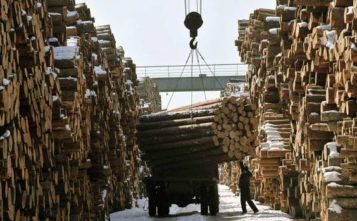Chinese enterprises have invested US$90 billion in 5,090 foreign companies in 156 countries, representing a year on YOY of 17%.
Out of the total, investments in Hong kong, ASEAN, EU, Australia, USA, Russia and Japan amounted to USD 65.5 billion, around 73% all overseas investments.
According to ITTO, investment flows to Hongkong, the EU and Japan fell in 2013 compared to a year earlier. The value of China's investments grew in Russia (US$4.1 bil.), the US (US$4.2 bil.), Australia (US$3.9 bil.) and ASEAN (US $5.7 bil.). The greatest increase was seen in investments in Russian companies.
According to a report published by Forest Trends, 90% of China's outward FDI in 2013 was to service industries (33%) followed by mining (22%), wholesale and retail (15%), manufacturing (10%), construction (7%) and transportation (3%).
Chinese Overseas Investment in Forestry and Industries with High Impact on Forests: Official Guidelines and Credit Policies for Chinese Enterprises Operating and Investing Abroad report shows that the pace of growth in investment in the construction sector was particularly high in 2013.
The data from the Ministry of Finance indicates that some 527,000 Chinese workers were sent to foreign companies in 2013, a YOY increase of 15,000 employees. All in all, by the end of 2013, China had around 7 million people overseas employed in support of its outward investments.
The majority of China's outward FDI originates from state-owned enterprises (national, provincial, and municipal), although the government is encouraging outward FDI by private enterprises. Geographically, enterprises in the industrial and commercial centers in the coastal cities and provinces are responsible for most outward FDI.
Provinces where forestry and wood processing is strong, such as Shandong and Yunnan, tend to feature in FDI in the timber sector. A powerful incentive for outward FDI is provided by the government in the form of financial backing.
Chinese enterprises on an approved list benefit from the government's financial support in the form of access to below-market rate loans, direct capital contribution and subsidies associated with official aid programs.
The incentives are backed up by various guidelines to banks and financial institutions to encourage them to ensure their clients comply with environmental and social standards, including host-country laws and regulations. The most recent green credit guidelines (2012) are the most comprehensive yet, but as with the other guidelines, their implementation has so far been patchy.
However, the government has plans to enforce them more strictly. All guidelines and policies share the basic and fundamental requirement that host - country laws and regulations must be followed. Despite the poor implementation of past guidelines the most recent environmental protection and green credit guidelines offer clear opportunities for host-country governments, NGOs, and campaigners to highlight occasions where Chinese companies are operating in breach of their own government's regulations and laws.
Direction of outward investments
According to records kept by China's Ministry of Commerce, investments in forestry and other land-use sectors have been made in the following regions and countries:
- Africa : Fourteen countries in Africa have received FDI in agriculture and fo restry, in particular Gabon , Zambia, Equatorial Guinea, Liberia, Republic of Congo and Cameroon.
- Asia : Outward FDI in logging and processing has been mainly directed to Laos, Myanmar, Thailand, and Korea . Efforts have been made to establish plantations in areas previously under opium poppy cultivation in Laos, Thailand, and Myanmar.
- Latin America and Caribbean : While less significant than Africa or Asia, Chinese investments have been expanding in Brazil, Argentina, Venezuela, Peru and Guyana.
- Russia: Chinese investment has focused on logging, timber processing, pulp and paper and other products and is concentrated in the border areas in Siberia and the Russian Far East. Chinese outward FDI has been encouraged by the Russian and Chinese governments through supportive programmes that began in 1997.








Leave a Reply